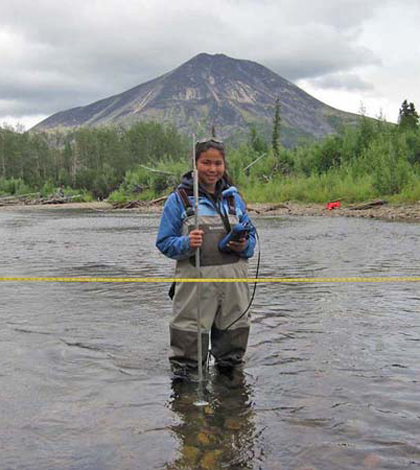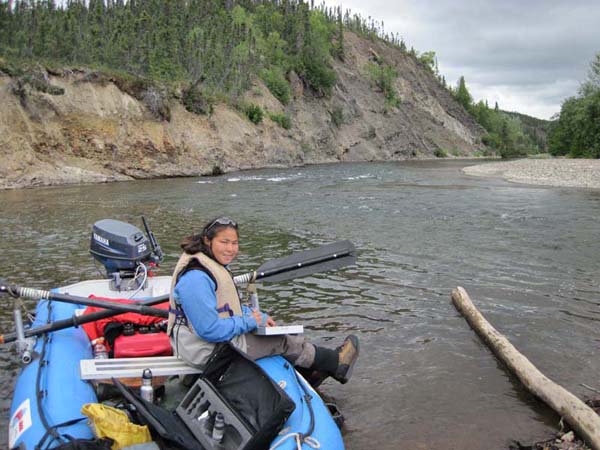Once-vacant village gathers baseline data on Southwest Alaska stream

Kristy Wise takes a flow measurement on the Holokuk River (Credit: Dave Cannon)
The Kuskokwim River–the second-longest river in Alaska and the longest free-flowing river in the U.S.–winds through state’s remote Southwest where isolation drives gas up to $7.50 a gallon.
“Here in the Kuskokwim, this is what some people refer to as ‘Real Alaska,'” said Dave Cannon, environmental director of the Native Village of Napaimute, which sits on the north bank of the river. “You could go to Anchorage and it would be just like any other big city. But you get out here–you can only get to where I’m at by airplane or boat.”
Napaimute played a historically important role in mining and fur trading in the region, but the village mostly vacated when those industries dwindled in the area. “Now the people that have roots there are trying to re-establish the village of Napaimute and make it a full-time village someday,” Cannon said.
That effort included gaining federal recognition as an Alaskan Native Tribe and adding Cannon’s position, which is funded by the U.S. Environmental Protection Agency.
Cannon’s role as environmental director recently had him collecting water quality data on the Holokuk River, a small tributary to the Kuskokwim. The remote location required some logistical planning, including carrying a satellite phone in case he and Kristy Wise, who assisted him on the trip, found themselves in the sort of trouble that they couldn’t get themselves out of.
But while the conditions for their survey might be rugged by some standards, Cannon said, it was “not that big of a deal” compared to some Alaskan stream surveys that require a a flight to get to the location.
“It’s within two or three miles of our village,” Cannon said. “We store the boats and I sleep in a comfortable bed. It’s just a one day trip to go up and do what we needed to do there.”

Wise takes notes at Cabin Creek, a Holokuk tributary (Credit: Dave Cannon)
The data collection included discharge measurements of the mainstem and tributaries with an OTT MF pro Flow Meter. They also collected pH, dissolved oxygen, salinity, temperature, total dissolved solids, conductivity and specific conductance data with a YSI 556 handheld meter.
The survey will provide a set of baseline data for the Holokuk, which has seen very little development and human traffic. Though the stream gets a run of five salmon species, it’s not as productive as other streams in the region which are frequently floated by out-of-state fishermen.
But in several years, the site could be within 40 miles of a gold mine that would be among the largest the U.S. has ever seen. The proposed Donlin Gold project has entered the environmental impact statement phase, which could take another three years, Cannon said.
Meanwhile, Cannon said the data will go to the Alaska Department of Fish and Game, as well as a drainage-wide water quality database developed by the nearby village of Georgetown.
While they collected the data, Cannon said they encountered a few black bears, bald eagles, and just maybe a wolverine.
“It was something in the water just ahead of us,” he said. “I saw it swimming, and it was pretty brushy as it climbed out. I saw this big bushy tail. The only thing I could think of was that it was a wolverine. We don’t see those very often.”
The region may not attract tourists like some of Alaska’s high-profile spots. But with that sort of chance sighting lurking around the riverbend, it’s not a bad place to live and work.
“This is my personal perspective,” Cannon said. “We don’t have the scenic beauty like Bristol Bay or Glacier Bay and Denali. It is beautiful, though, in its own right. And it’s pristine.”
Top image: Kristy Wise takes a flow measurement on the Holokuk River (Credit: Dave Cannon)





0 comments